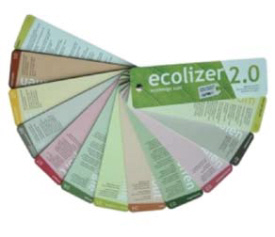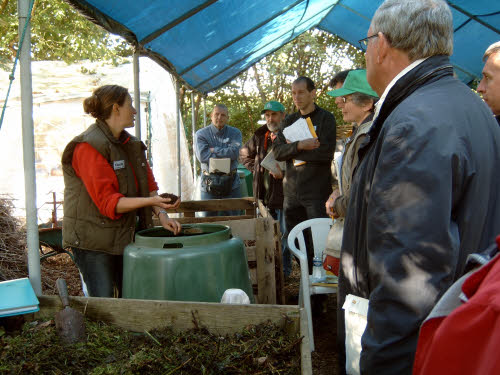One of Flanders’ central strategies to prevent waste goes to the root of the waste problem: the very design of products. To address this, the agency has created a set of tools to promote clean production and sustainable design. These include:
-

The Ecolizer “ECOLIZER” – a tool for designers to estimate the environmental impact of products. It includes a set of indicators relating to materials, processing, transport, energy, and waste treatment, allowing designers to identify opportunities to reduce those impacts by changing the design.
- Eco-efficiency assessment – a program to evaluate the efficiency of small and medium companies. It identifies points of intervention for reducing waste, improving energy and water efficiency, increasing recycling, and so on. The test is free of charge.
- Inspirational online database – a collection of case studies of businesses that have implemented clean production and eco-design methods.
In 2008, $1.19 million in subsidies were given to reuse and recycling centers. In 2009, Flanders had over 110 second-hand shops employing a total of 3,861 employees and serving over 3.6 million paying customers. The government also organizes “Ecodesign awards” for students and professionals as a way to encourage innovations in waste prevention. The prizes range between $508 and $5,080.
Flemish waste legislation makes it mandatory for producers, importers, and retailers of certain items to take back waste products and meet collection and recovery targets. These obligations apply to batteries and accumulators, vehicles, printed matter, tires, electrical and electronic equipment, lubricating and industrial oils, lighting equipment, animal and vegetable fats and oils, and medicines. People can return broken or obsolete products to retailers free of charge. Producers are then responsible for management and treatment of the products according to specific requirements that include recovery targets. By law, new construction projects that generate over 1,000 m3 of debris must present a “deconstruction” plan and waste inventory and are responsible for recycling this waste. According to OVAM, 90 percent of construction and demolition waste—11 million tons—was recycled in 2010.
Waste Prevention Strategies Directed at Households and Individuals
Pay As You Throw (PAYT). The hallmark of this significant waste prevention strategy is the application of graduated taxes to different types of waste. Most expensive is the collection of residual waste, followed by the collection of organic materials, with the lowest taxes applied to plastic bottles, metal packaging, and drink cartons. Collection of paper and cardboard, glass bottles, and textiles is free. Tax on bulky waste varies depending on the quantity.
Home composting. Successful approaches to promote composting have included annual charges for the collection of organic materials ($51 for a 120 liter bin), educating citizens about home composting through communication campaigns, promoting “cycle gardening” to reuse yard waste, encouraging composting at schools, and composting demonstrations at community compost plants. An estimated 100,000 tons of organic materials were kept out of the collection and management system in 2008, thanks to home composting. In densely populated areas, the government encourages community compost plants, where citizens can take their organic materials. These facilities usually use compost bins, and so do not take up much space. By 2010, approximately 34 percent of the Flemish population—almost two million people—was composting at home.
Green event assessment and guide. Online tools are available for organizers to calculate the ecological footprint of their events and to prevent waste during events. The agency also maintains an online list of places that lend reusable tableware for events and parties. Additional waste prevention campaigns for citizens include promoting the use of tap water instead of bottled, encouraging bulk purchasing, discouraging the use of packaging and disposable bags, and providing “Please No Publicity” stickers distributed to citizens to reduce junk mail.
Regulating Products That Enter the Market
Although waste management is a local and regional responsibility, the Belgian federal government sets the standards for products that enter the market and eventually become waste. These policies include an Eco-tax Act for items like beverage containers, some packaging, and disposable cameras and batteries; a federal act that discourages producers from manufacturing items that increase waste problems or pose health or pollution risks; the adoption of standard labels for products meeting certain environmental and social criteria; and the publication of a green procurement guide.
Throughout Belgium, packaging is the producer’s responsibility. Nearly all the companies that produce household packaging are grouped in a single organization known as FOST Plus. Each participating company pays a fee based on the type and amount of packaging they are responsible for introducing into the market. The organization funds the public collection, sorting, and recycling of these materials. According to FOST Plus, the recycling rate for household packaging in Belgium has increased from 28 percent in 1995 to 91.5 percent in 2010.
Flanders accounts for 60 percent of the total household packaging recycled in the country (415,763 tons in 2010). FOST Plus estimates that compared to incineration, recycling prevented the emission of 860,000 tons of CO2. A 2006 study estimated that the total cost per inhabitant for the packaging management system in Belgium, accounting for income from recycling sales, was $7.34 per year.
By dividing responsibility appropriately between municipal, regional, and national governments, Flanders has successfully implemented a comprehensive strategy for waste prevention, recycling, and composting. The results speak for themselves: stable waste generation and the highest diversion rate in Europe.
Check out GAIA’s website here, download the full Zero Waste report here, and follow GAIA on Facebook and Twitter.
Read more from Other Worlds here, and follow us on Facebook and Twitter!
Copyleft GAIA. You may reprint this article in whole or in part. Please credit any text or original research you use to GAIA.
Top image credit: VLACO

